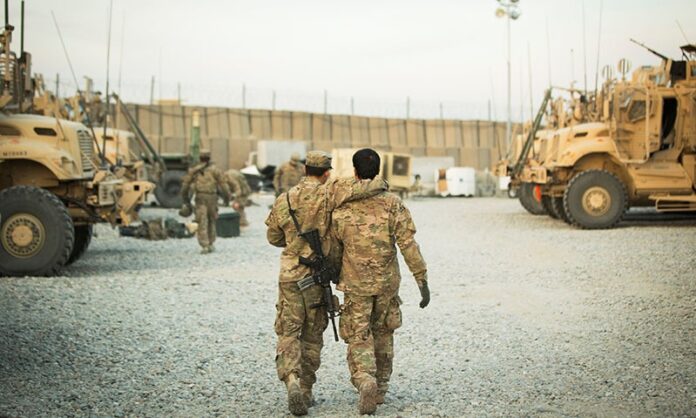As United States troops quietly quit their last key bases in Afghanistan last weekend, Russian-backed Syrian forces were stepping up their bombardment and siege of Idlib and preparing for a possible closure of the last humanitarian crossing from Syria to Turkey.
It was a reminder of just how much the Middle East and South Asia have changed since Nato forces began their attempts to stabilise Afghanistan 20 years ago. As late as the Libya intervention in 2011 and against Islamic State as recently as 2019, the United States was still the key intervening power in conflicts, at least when it wished to be.
On rare occasions, that might remain the case even with the number of troops reduced to a few hundred in Iraq and Syria, plus now a similar sized detachment guarding the US embassy in Kabul. US air and naval forces remain significantly more powerful than any other player. On the ground where it counts, however, other players are now dominant, facing off for influence in a way that has already redefined the wars in Libya and Syria.
Indeed, whether America itself really knows what role it wants to play remains unclear. Institutionally, the US military and many agencies of the US government have been embroiled in the Mideast and Afghanistan for so long they may inevitably wish to remain engaged. The domestic and other drivers to pull back, however, are becoming ever stronger.
Going forward in Afghanistan, the ongoing presence of US and British troops guarding their respective embassies is largely dependent on a Turkish deal to retain control of Kabul airport, now likely to become the only other significant international presence in the country.
As in multiple other conflicts, Turkey is looking to position itself as a key international player but Russia, China and other states also see opportunities to increase influence and mitigate risks.
CHINA IN PAKISTAN, RUSSIA IN TAJIKISTAN:
For China, that means deepening discussions with long-term partner Pakistan and the authorities in Kabul, reportedly including a potential motorway from the Afghan capital to Peshawar in Pakistan’s Khyber Pakhtunkhwa. That could revolutionise the region and significantly antagonise India but would require a very different security situation.
Russia’s closest central Asian ally, Tajikistan, on Wednesday requested Moscow’s support to secure its mountainous border with Afghanistan. Moscow has its own history in Afghanistan, but as in the Middle East, it is unlikely to pass up an opportunity to supplant the United States and has stepped up diplomatic and military outreach across Central Asia.
According to local media reports, some of Afghanistan’s most significant roads now pass through Taliban control and 15 of Afghanistan’s 34 regional capitals are now largely encircled by the militants, including the key northern city of Mazar-i-Sharif. US intelligence estimates cited by US media predict the Afghan government itself could fall in six months to a year although with Afghan troops already said to be melting away in some areas, any unravelling could come faster.
In Libya, Syria, Iraq and Yemen, Washington remains involved to various degrees but other nations are now often more influential. That has particularly benefited Russia, which now has a significant presence in Syria and Libya supporting its much more assertive naval forces in the eastern Mediterranean. Regional dynamics are more complex still, benefiting smaller powers.
LARGELY UNREPORTED WARS:
In Libya, where Washington and its Nato allies marshalled an ad hoc coalition to oust Muammar Gaddafi in 2011, the war is now a complex fight between elements backed by foreign powers including Russia, Turkey, the United Arab Emirates, Egypt, France and others, in part driven by a desire for oil and gas reserves.
In Syria, where the United States retains a modest military presence in some oil-rich Kurdish areas, the primary drivers of the conflict now include a much broader confrontation between the Russian-backed regime of Bashar al-Assad and Turkey, which controls some areas along the border with its own troops and Turkish-backed militias.
As well as shaping the war on the ground with troops and air power since its intervention began in 2015, Russia has also used its veto at the United Nations to control diplomatic actions on Syria, including the latest potential border closure.
In contrast to 2011, developments in these conflicts are now barely covered by international media. Activities of US forces are also much more unreported with little clarity, for example, over reported explosions at a US base in Syria this week.
Indeed, many of the key developments in US-Mideast relations such as the visit to Washington this week of Saudi Deputy Defence Minister Prince Khalid bin Salman go largely unreported or at least officially unannounced. The same goes for an uptick in US strikes against Iranian-backed forces in Iraq earlier this month, one country where the United States remains more involved than expected after withdrawal of combat troops but has also seen its power fade.
What happens next in Afghanistan may go similarly largely ignored. Most coverage so far has focused on what the United States and Britain might do next, not what is happening on the ground. Whether Turkey can control the international airport may come down to whether it is able to strike a deal with a dramatically resurgent Taliban but the details of that and whether or not it truly happens may also barely be reported.
That doesn’t mean multiple countries will not be paying attention. The West might wish Afghanistan had ceased to exist once its troops are no longer there, but in many ways the 21st-century “Great Game” for influence there is only just beginning.























